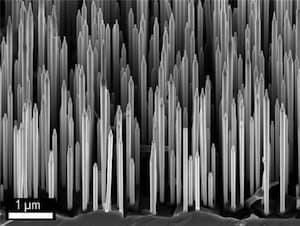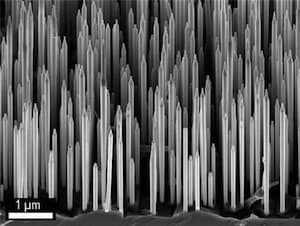
While we work for the eventual development of a nanotechnology that transforms human life via atomically precise manufacturing, the partial control of the configuration of atoms in important materials that is afforded by current nanotechnology promises great near-term advantages. A decade ago, Foresight focused on progress in nanotechnology to meet six major challenges faced by humanity. Although we haven’t said as much the past several years about these challenges (except for #3, Improving Health and Longevity), recent progress promises great contributions to the other challenges as well. Challenge #1, Providing Renewable Clean Energy, appears soon to profit from advances in controlling the atomic configuration of gallium arsenide nanowires. Patrick Cox’s Tech Digest reports on “Building a Better Solar Cell One Atom at a Time“. Citing work by researchers at the Norwegian University of Science and Technology working with IBM engineers to grow gallium arsenide nanowires on graphene, he concludes:
… With a better understanding of how, atom by atom, a panel’s composition could be manipulated to achieve maximum output, solar-panel technology of the future promises to become lighter and more portable, as well as easier to manufacture and maintain. …
A hat tip to ScienceDaily for providing more details by reprinting news published by the Norwegian University of Science and Technology “Better Solar Cells, Better LED Light And Vast Optical Possibilities“:
Changes at the atom level in nanowires offer vast possibilities for improvement of solar cells and LED light. NTNU-researchers have discovered that by tuning a small strain on single nanowires they can become more effective in LEDs and solar cells.
NTNU researchers Dheeraj Dasa and Helge Weman have, in cooperation with IBM, discovered that gallium arsenide can be tuned with a small strain to function efficiently as a single light-emitting diode or a photodetector. This is facilitated by the special hexagonal crystal structure, referred to as wurtzite, which the NTNU researchers have succeeded in growing in the MBE lab at NTNU. The results were published in Nature Communications [abstract].
… By altering the crystal structure in a substance, i.e. changing the positions of the atoms, the substance can gain entirely new properties. The NTNU researchers discovered how to alter the crystal structure in nanowires made of gallium arsenide and other semiconductors.
With that, the foundation was laid for more efficient solar cells and LEDs.
“Our discovery was that we could manipulate the structure, atom by atom. We were able to manipulate the atoms and alter the crystal structure during the growth of the nanowires. This opened up for vast new possibilities. We were among the first in the world who were able to create a new gallium arsenide material with a different crystal structure,” says Helge Weman at the Department of Electronics and Telecommunications.
… The next big news came in 2012. At that point, the researchers had managed to make semiconductor nanowires grow on the super-material graphene. Graphene is the thinnest and strongest material ever made. This discovery was described as a revolution in solar cell and LED component development.
… The research group has received a lot of international attention for the graphene method. Helge Weman and his NTNU co-founders Bjørn-Ove Fimland and Dong-Chul Kim have established the company CrayoNano AS, working with a patented invention that grows semiconductor nanowires on graphene. The method is called molecular beam epitaxy (MBE), and the hybrid material has good electric and optical properties.
“We are showing how to use graphene to make much more effective and flexible electronic products, initially solar cells and white light-emitting diodes (LED). The future holds much more advanced applications,” says Weman.
… The last couple of years the research group has, among other things, studied the unique hexagonal crystal structure in the GaAs nanowires.
“In cooperation with IBM, we have now discovered that if we stretch these nanowires, they function quite well as light-emitting diodes. Also, if we press the nanowires, they work quite well as photodetectors. This is facilitated by the hexagonal crystal structure, called wurtzite. It makes it easier for us to change the structure to optimise the optical effect for different applications.
“It also gives us a much better understanding, allowing us to design the nanowires with a built-in compressive stress, for example to make them more effective in a solar cell. This can for instance be used to develop different pressure sensors, or to harvest electric energy when the nanowires are bent,” Weman explains.
Because of this new ability to manipulate the nanowires’ crystal structure, it is possible to create highly effective solar cells that produce a higher electric power. Also, the fact that CrayoNano now can grow nanowires on super-light, strong and flexible graphene, allows production of very flexible and lightweight solar cells.
The CrayoNano group will now also start growing gallium nitride nanowires for use in white light-emitting diodes.
“One of our objectives is to create gallium nitride nanowires in a newly installed MBE machine at NTNU to create light-emitting diodes with better optical properties — and grow them on graphene to make them flexible, lightweight and strong.”
This work illustrates beautifully the practical benefits from increasing ability to control the configuration of atoms in materials. This work uses currently available tools to control the atomic configuration of bulk materials. Atomically precise manufacturing, when it is developed, will allow specifying different atomic configurations to produce, if needed, nanometer scale complexity throughout a microscale or macroscale object to manufacture enormously complex systems of materials, devices, and molecular machines.
—James Lewis, PhD
